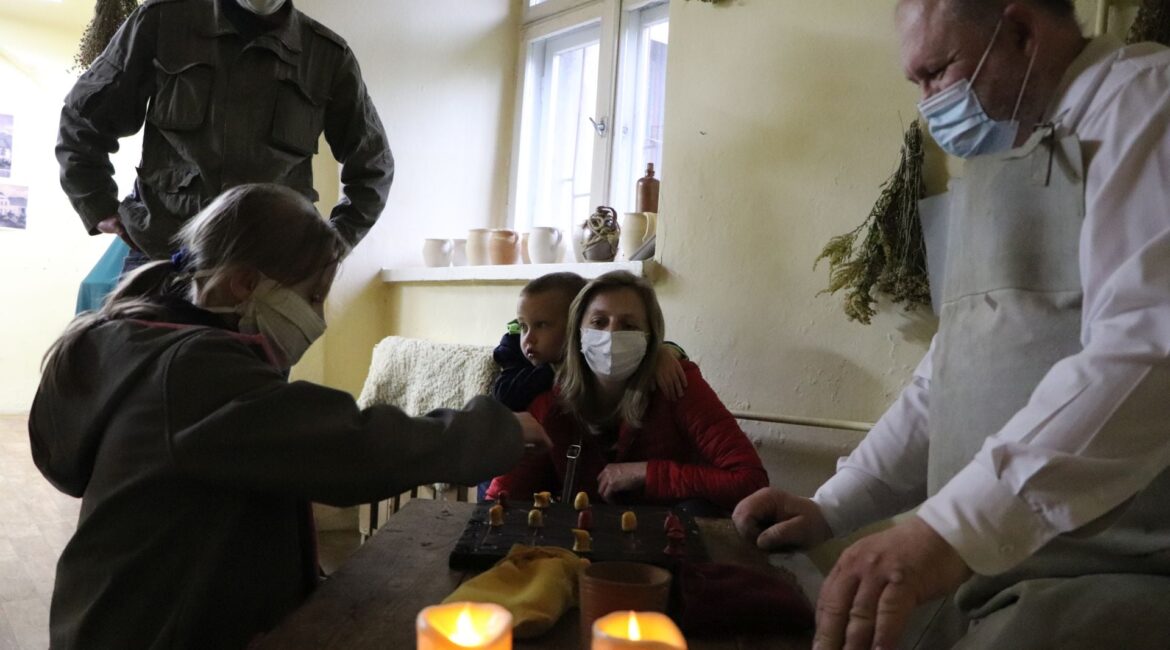On the occasion of the European Museums Night on May 15, 2021, the Ceramics Museum invited Bolesławiec citizens for a night tour of the Pückler Palace, an abandoned historic building at Zgorzelecka street, which in the coming years will be adapted as the new museum headquarters.
Selected rooms have been turned into time capsules presenting the most important moments from the building’s history, as well as the concept of its reconstruction. At the entrance, visitors received a leaflet with a short description of all the attractions, and it was also possible to purchase our latest publications at a promotional price: “The pre-war picture of Bolesławiec in the collections of museums and archives” and “Bolesławiec ceramics in museum collections”.
The first point on the sightseeing route was the room of the former inn, which stood in this place until the beginning of the 19th century. Instead of food and drinks, the innkeeper Tadeusz served stories about old times, and the professional dice player Darek invited all daredevils to play at least one game.
In the 1870s, Franz Hatzfeld zu Trachenberg, a great lover of music and horses, settled down in the palace. In his residence, he organised unique concerts for the local elite, and built a riding school, as well as a riding track in the adjacent park. In his honour, a music lounge was arranged in one of the rooms, where the master of old instruments, Michał, played to accompany the dancers and helped in mastering the steps of the waltz.
The office of Samson Woller, the owner of the “Concordia” textile factory, is hidden behind a labyrinth of canvas. From 1880, the palace served as Woller’s temporary home and office, during his numerous business trips. On his behalf, chairman Adam talked about the company’s history and looked for partners to implement new projects.
Right next to it, the younger librarian Dorota was writing out reading cards for visitors, affixing commemorative seals to museum publications and handing out occasional stickers. She also showed the way to the apartment where Oskar Herbert Müller, a literary expert and critic, theatre lover and, above all, the manager of the library operating in the palace in the 1920s, grew up. There, the butler Jacek told visitors about his turbulent childhood.
On the way to Müller’s apartment, one could stop for a moment of respite in the magic park of Eduard Petzold, a well-known designer of green areas, famous for the landscape park in Bad Muskau/Łęknica. Here, gardener Jarosław explained where in Bolesławiec you can see trees planted according to Petzold’s plans.
During the times of the Polish People’s Republic, the palace was the seat of the Bolesławiec Construction Enterprise, which is why a secretary’s office appeared in the former canteen. That was the kingdom of Mrs. Ania – you could find there herself, sipping her tea, and – cheered up by the motivating choral songs of that era – laboriously writing a Very Important Management Report. She took great pains not to confuse the crucial man-hours with the staff-kilometre figures. If you filed a proper application on the 3B/DP/1982-ag form, you could get a ZWC/8adxkv/30038-IND/ confirmation from Mrs. Ania, with the purpose of getting a proper coal allowance.
At the end of the route, in a clairvoyants cabinet, Madame Barbara and Monsieur Michel, waited for the visitors. With the help of a magic glass ball, they answered all questions about the future of the palace. Those still not satisfied could submit own motions and complaints to Mrs. Ania.
The Museum of Ceramics would like to thank all the people and institutions without whose help and kindness the whole project would not have been possible:
- for making the facility available to: Lindner Polska Sp. z o. o. and the Municipality of Bolesławiec;
- for supporting the preparations: Zygmunt Brusiło, Danuta Maślicka, Dariusz Rataj, Andrzej Świderski, , Adam Baniecki (head of the State Archives in Wrocław, Branch in Bolesławiec); to Bolesławiec City Hall staff: Agnieszka Gergont, Krzysztof Hewak, Dariusz Rutyna and Robert Rzepnicki; to Dariusz Uściński (director of the Stanisław Wyspiański Youth Cultural Centre in Bolesławiec); Katarzyna Sas; Anna Idkowiak (director of the Municipal Public Library – Knowledge Centre in Bolesławiec); Kornel Filipowicz (director of the Bolesławiec Culture Center – International Center of Ceramics); Jacek Głomb (director of H. Modrzejewska Theatre in Legnica);
- for help in handling the event: Adam Faltyn, Darek Gołębiewski, Oliwia Gorczyca, Przemysław Kania, Angelika Staniewska, Amelia Staniewska, Dorota Strzelczyk and Radek Szweda.

